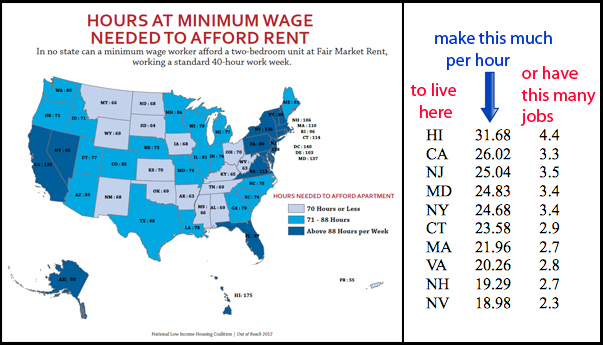
To rent a two-bedroom apartment in Hawaii, you need either a job that pays $31.68 per hour, or four minimum-wage jobs. Closer to 4.5, actually. In California, you need either a job that pays $26.02 per hour, or more than three minimum-wage jobs. And so on.
This is a much-simplified sample of the kind of information available from the report called “Out of Reach 2012,” compiled by the National Low Income Housing Coalition. You can download the entire report on its website, or various charts and graphs such as the one at the top left of the page, which is much easier to read in full size.
It would be interesting to have overlay maps, to see where all the empty foreclosed properties are, and the areas where the most people are away in jail, and where the largest concentrations of homeless people are, and several other variables, compared to these rent figures.
We learn from Aaron Sankin in The Huffington Post that the very most expensive place to live isn’t a state at all, but a metropolitan area which includes the District of Columbia and parts of Virginia and Maryland. By strange coincidence, this is the very area where the people who make the laws live, and also the ones who influence and reward the lawmakers on behalf of corporations. By another strange coincidence, Washington, D.C., our nation’s capital, contains an enormous number of people experiencing homelessness.
Across the nation, the rate of home ownership is the lowest since 1998, so, naturally, more people are looking for places to rent. Good luck with that, prospective renters! Reviewing the Out of Reach information, Sankin says:
The report notes that the number of low-cost rental properties around the country have shrunk as a growing fraction are converted into significantly more expensive units or left to fall into disrepair and taken off the market entirely. Between 2007 and 2010, the number of properties priced at under $500 per month dropped by one million, while those going for over $1,205 increased by two million.
Economic homelessness is the concept introduced by Richard R. Troxell in Looking Up At the Bottom Line. The economic homeless are the working poor who have some kind of a job, but don’t make nearly enough to rent even the most rudimentary and utilitarian kind of apartment.
If you want to get your heart broken, read about Project Fresh Start. At one point, Troxell obtained funding for a program in which 20 adults went through a “continuum of care” program, and found work and housing. Within two years, all were homeless again, not through personal failings or lack of trying, but because people just can’t live on what they make. Richard writes:
We had gotten downtrodden people engaged, brushed off, detoxified, job trained, placed in jobs, and into housing only to realize that they were destined to fail as the wage, set by the federal government, would not sustain them. This was a powerful epiphany.
Like any epiphany worthy of the name, this one led to action: the proposal for the Universal Living Wage. The idea is to fix the Federal Minimum Wage by indexing it to the local cost of housing throughout the United States. The military already does this. In many places, not all military personnel live within the borders of the installations. When the government calculates their off-base housing and separate rations allotments, it goes according to the geography and the local cost of living. It’s not rocket science.
At least 40% of people experiencing homelessness, are working at some point during the week. Clearly, the work ethic is there, but the wage to afford basic housing is not. Richard points out that minimum-wage gigs used to be “starter” jobs, just a dip of the toe into the water, to learn what the world of work is all about, before a person would move on to a career or a real job and a union membership, something more solid. But now, an American is more likely to be trying to support an entire family on a minimum-wage job, that is, if a job can be obtained at all.
But why tell the whole story here? Please accept this invitation to the Universal Living Wage website, where there is so much more. It opens up a new world of possibility.
Reactions?
Source: “Out of Reach 2012,” NLIHC.org, 2012
Source: “San Francisco Rents The Highest Of Any City In Country,” The Huffington Post, 03/14/12
Source: “Looking Up at the Bottom Line,” Amazon.com
Image of “Out of Reach 2012” map (left) is used under Fair Use: Reporting.
Chart of the right is by Pat Hartman.


